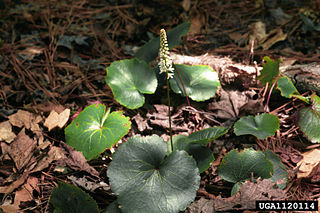
Galax, the wandplant, wandflower, or beetleweed, is a genus in the flowering plant family Diapensiaceae, containing a single species, Galax urceolata. It is native to the southeastern United States from Massachusetts and New York south to northern Alabama, growing mainly in the Appalachian Mountains at altitudes of up to 1,500 m, where it grows in shaded places in forests. Galax urceolata can occur at multiple ploidy levels, an individual may be a diploid (2x), triploid (3x), or autotetraploid (4x) (autopolyploid). The cytotypes are neither morphologically nor geographically distinct, though there are slight climatic differences between the diploid and autotetraploid types. Outcrossing is likely to occur among cytoypes as well.

Acalypha is a genus of flowering plants in the family Euphorbiaceae. It is the sole genus of the subtribe Acalyphinae. It is one of the largest euphorb genera, with approximately 450 to 462 species. The genus name Acalypha is from the Ancient Greek ἀκαλύφη (akalúphē) ("nettle"), an alternative form of ἀκαλήφη (akalḗphē), and was inspired by the nettle-like leaves. General common names include copperleaf and three-seeded mercury. Native North American species are generally inconspicuous most of the year until the fall when their stems and foliage turn a distinctive coppery-red.
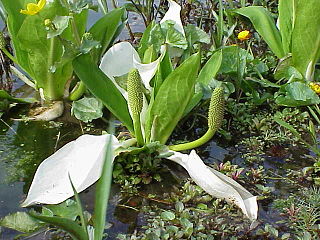
Lysichiton is a genus in the family Araceae. These plants are known commonly as skunk cabbage or less often as swamp lantern. The spelling Lysichitum is also found. The genus has two species, one found in north-east Asia, the other in north-west America.

Clintonia borealis is a species of flowering plant in the lily family Liliaceae. The specific epithet borealis means "of the north," which alludes to the fact that the species tends to thrive in the boreal forests of eastern Canada and northeastern United States.
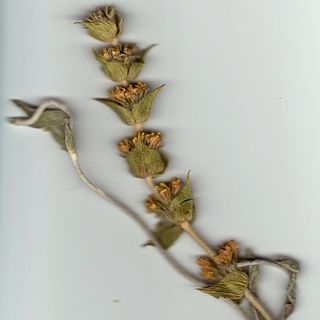
Sideritis, also known as ironwort, mountain tea, and shepherd's tea, is a genus of flowering plants known for their use as herbal medicine, commonly as an herbal tea. They are abundant in Mediterranean regions, the Balkans, the Iberian Peninsula and Macaronesia, but can also be found in Central Europe and temperate Asia.

Nepenthes papuana is a tropical pitcher plant endemic to New Guinea. The specific epithet papuana is derived from Papua, an alternative name for the island.

Crataegus laevigata, known as the Midland hawthorn, English hawthorn, woodland hawthorn, or mayflower, is a species of hawthorn native to western and central Europe, from Great Britain and Spain east to the Czech Republic and Hungary. It is also present in North Africa. The species name is sometimes spelt C. levigata, but the original orthography is C. lævigata.

Hydrocotyle, also called floating pennywort, water pennywort, Indian pennywort, dollar weed, marsh penny, thick-leaved pennywort and even white rot is a genus of prostrate, perennial aquatic or semi-aquatic plants formerly classified in the family Apiaceae, now in the family Araliaceae.
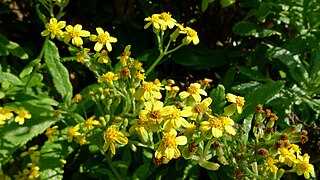
Senecio madagascariensis, also known as Madagascar ragwort, is a species of the genus Senecio and family Asteraceae that is native to Southern Africa. Other common names include Madagascar groundsel and fireweed. It has been included on the noxious weeds list for Hawaii and the reject list for Australia. S.madagascariensis is the diploid cytotype of S.inaequidens.

Petrophile macrostachya is a species of flowering plant in the family Proteaceae and is endemic to southwestern Western Australia. It is an erect shrub with prickly, pinnate or lobed leaves, and oblong or cylindrical heads of glabrous yellow to cream-coloured flowers.

Geranium reuteri, the giant geranium, is a species of flowering plant in the family Geraniaceae, native to the Canary Islands. It was known for many years under the name Geranium canariense. In Spanish, it is called pata de gallo.

Rubia peregrina, the common wild madder, is a herbaceous perennial plant species belonging to the bedstraw and coffee family Rubiaceae.

Clerodendrum umbellatum is a scandent African shrub of the family Lamiaceae, but previously placed in Verbenaceae. It is found in Tropical Africa, Central America and Tropical Asia, its distribution being to some extent anthropogenic, and is often planted for its showy flowers. The genus Clerodendrum is large with more than 300 species currently accepted.
Coreopsis integrifolia, the fringeleaf tickseed or mouse-ear tickseed, is a North American plant species of the family Asteraceae. It is native to the southeastern United States, in South Carolina, Georgia, and northern Florida.

Myriopteris lanosa, the hairy lip fern, is a moderately-sized fern of the eastern United States, a member of the family Pteridaceae. Its leaves and stem are sparsely covered in hairs, but lack scales, hence its common name. One of the cheilanthoid ferns, it was usually classified in the genus Cheilanthes until 2013, when the genus Myriopteris was again recognized as separate from Cheilanthes. It typically grows in shallow, dry, soil, often in rocky habitats.

Zieria pilosa, commonly known as hairy zieria, is a plant in the citrus family Rutaceae and is endemic to coastal New South Wales. It is a shrub with hairy branches, leaves composed of three leaflets and usually only single white to pale pink flowers in the leaf axils.
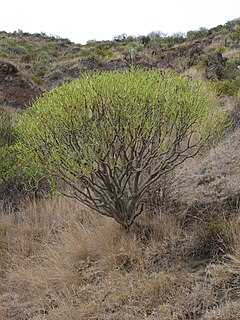
Euphorbia lamarckii is a species of flowering plant in the family Euphorbiaceae, native to the western Canary Islands. It resembles Euphorbia regis-jubae, with which it has been confused. Both have been called Euphorbia obtusifolia.
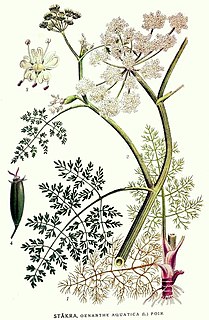
Oenanthe aquatica, fine-leaved water-dropwort is an aquatic flowering plant in the carrot family. It is widely distributed from the Atlantic coast of Europe to central Asia.
Pseuduvaria beccarii is a species of plant in the family Annonaceae. It is endemic to New Guinea. Rudolph Scheffer, the Dutch botanist who first formally described the species using the basionym Orophea beccarii, named it after Odoardo Beccari, the Italian naturalist who collected the sample he examined.
Polygala multiflora is a plant species in the milkwort family (Polygalaceae). It is native to Western Africa. It is an erect plant and is considered to be "probably 2 to 3 feet " though it can grow up to 6 feet (1.8 m) tall. Its stems are puberlouous and its leaves are 2 to 3 inches long and 1⁄6 inch (0.42 cm) wide. The flowers it produces are blue or purple. It was first written about was part of the Encyclopédie méthodique Botanique in 1804 by Jean Louis Marie Poiret.


















